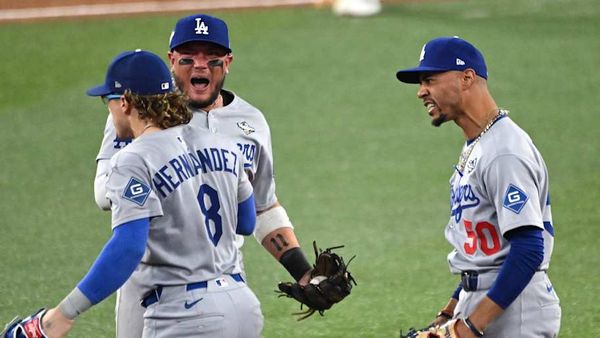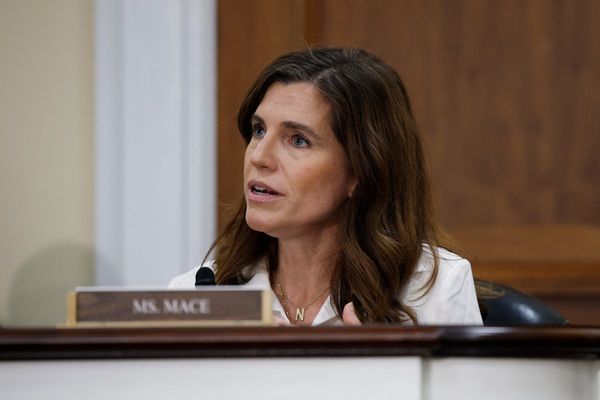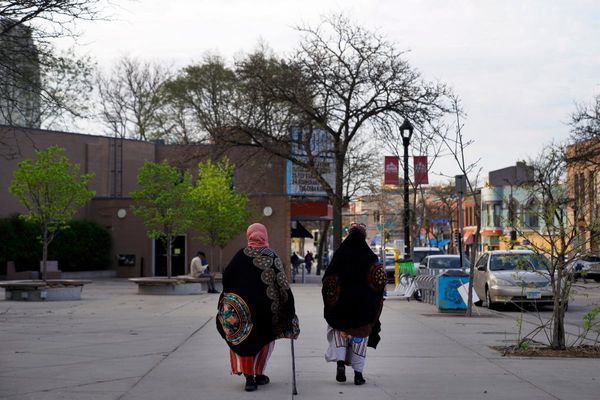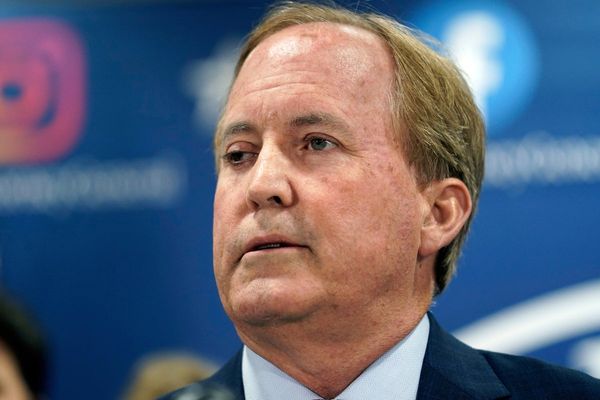Across the globe, anti-Indigenous organizations and sympathizers work to undermine the collective rights of Indigenous peoples. This collection of reports reveals some of the most common attacks Indigenous communities face today.
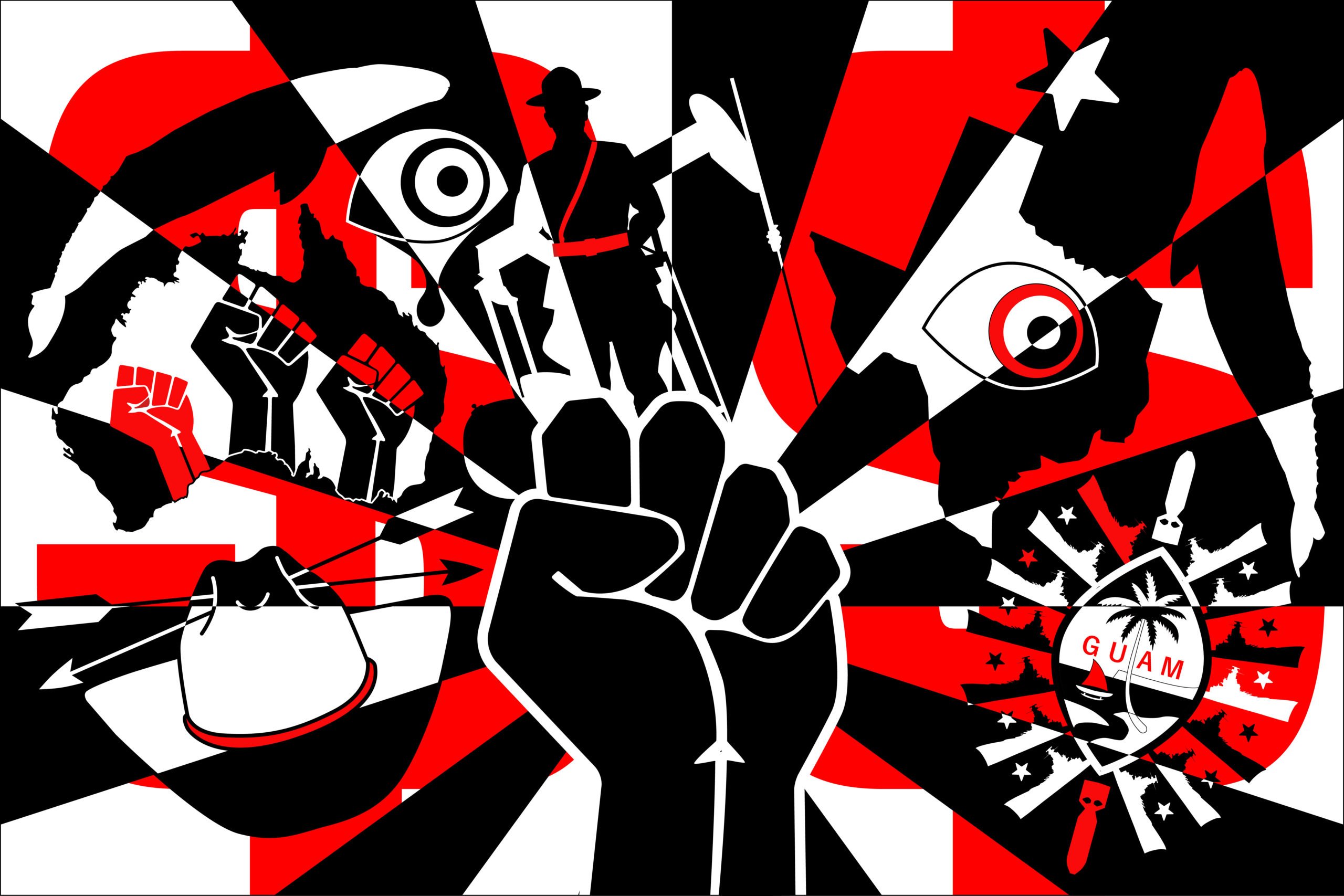
By Tristan Ahtone, Lorena Allam, Leilani Rania Ganser, Kalen Goodluck, Brittany Guyot, and Anna V. Smith
Illustrations by Marty Two Bulls Jr.
September 25, 2020
This article was reported in collaboration with The Aboriginal Peoples Television Network, The Guardian Australia, High Country News, and the Texas Observer. This project was created in partnership with the Indigenous Investigative Collective and the Economic Hardship Reporting Project.
On Sept. 13, 2007, despite opposition from Australia, the United States, Canada and New Zealand, the United Nations General Assembly adopted the U.N. Declaration on the Rights of Indigenous Peoples. UNDRIP, the culmination of more than 25 years of work at the U.N., articulated the individual and collective rights held by Indigenous communities and proposed protections for those rights.
“By adopting the Declaration, we are also taking another major step forward towards the promotion and protection of human rights and fundamental freedoms for all,” Sheikha Haya Rashed Al Khalifa, the General Assembly president at the time, said. “Even with this progress, Indigenous peoples still face marginalization, extreme poverty and other human rights violations,” she cautioned. “They are often dragged into conflicts and land disputes that threaten their way of life and very survival, and suffer from a lack of access to health care and education.”
Prior to UNDRIP, the International Labour Organisation’s adoption of Convention 169, a legally binding framework for countries with Indigenous populations, acknowledged and codified the rights of Indigenous peoples. That framework has been used successfully to safeguard Indigenous resources and territory. However, only 23 countries have adopted the convention, leaving gaping holes in enforcement and protection of human rights globally. There has been some progress since the passage of these protections; countries previously opposed to the text have reversed course and adopted the legislation. But where ILO-Convention 169 can be legally binding, the UNDRIP is a nonbinding document that sets standards but does not provide tools to address rights violations.
More than a decade after its passage, Al Khalifa’s warning remains pertinent; Indigenous Peoples continue to face violence, discrimination, and human rights violations. Across the globe, there are nearly 476 million Indigenous people. We live in more than 90 countries, speak more than 4,000 different languages. We occupy almost 22 percent of the planet’s land surface. But across the globe, a constellation of corporations, special interest organizations, politicians, lobbyists, and hate groups work to limit or eliminate said rights for Indigenous people. Those efforts are nothing new.
For modern states, especially those born from colonial projects like the United States and Australia, nationhood and anti-Indigenous sentiments have always been intertwined. But to date, there has been no concerted effort to understand just how deep these ideologies go or how they manifest. In part, this is because anti-Indigenous sentiments are cultural and political features, not systemic flaws or errors. The CHamoru of Guam, for instance, continue to fight for independence—a recommendation made by the U.N. Special Committee on Decolonization in the 1960s. Those efforts, however, have been curtailed by legal actions brought by U.S. citizens who refuse to allow the colony to be independent, and find support in Supreme Court opinions that refer to the CHamoru as an alien race, unable to govern themselves.
Anti-Indigenous ideologies challenge bedrock human rights through a number of means. Relying on stereotypes, for instance, is a common tactic in almost every country: Indigenous communities are seen as lawless or corrupt and incapable of managing land, water, wildlife or infrastructure—roles that anti-Indigenous activists and fellow travelers argue should be taken on by the state or corporations instead of Indigenous communities. Those same arguments are often extended to the adoption of Indigenous children, access to health care, and payment of taxes. In all cases, anti-Indigenous individuals and organizations argue that Indigenous people are incapable of managing their own affairs by engaging with racist dog whistles and established stereotypes to undermine rights to land, resources, language, and culture.
But the staying power of anti-Indigeneity is also due to a lack of education or understanding of Indigenous rights or relationships. A common thread utilized by purveyors of anti-Indigenous sentiments includes championing ideas of “equality,” that Indigenous peoples should not receive “special rights” and that all citizens should be equal before the law—an attack designed to undermine legal agreements, constructive arrangements, treaty rights, and government-to-government relationships with Indigenous communities and tribal nations—compelling arguments to individuals that have no understanding of why treaty rights or legal agreements exist in the first place.
Anti-Indigenous sentiments and ideologies take on a number of different shapes. In their most extreme forms, anti-Indigenous hate groups express clear intentions to assimilate or eliminate Indigenous people. On the opposite end of the spectrum, non-Indigenous individuals and organizations with environmental or even social justice track records often wade into anti-Indigenous rhetoric to wield litigation or win political fights. Globally, purveyors of anti-Indigenous ideologies work to undermine established rights by relying on a variety of doctrines and practices that find root in scientifically false, racist, and legally invalid arguments.
The core of anti-Indigeneity is in opposition to self-determination, political and cultural autonomy, and the right to maintain, use and protect traditional territories and resources. But from clear hate groups to fellow travelers and opportunists, there is little to no scrutiny of anti-Indigenous ideologies anywhere on the planet. This collection of reportage from across three countries and in collaboration with five institutions describes just a few of the ways in which anti-Indigeneity infiltrates our governments, agencies and lives.

INAFA’MAOLEK
In the shadow of the United States’ military empire, the centuries-long fight for CHamoru self-determination continues.
Guåhan, one of the Marianas Islands in the Western Pacific Ocean, has been called many names by many colonial governments throughout its history, which traces back five centuries. The Spanish, the first Europeans to reach and colonize the island in the 16th century, called it and the other Marianas Islas de Los Ladrones, or the Islands of Thieves. In the 1898 Treaty of Paris, the Spanish ceded the island to the United States, which called the island Guam. During World War II, the island became known as the Tip of the Spear, because of its important role as a mid-Pacific outpost.
But to CHamorus, the Indigenous people of the island, the island is Guåhan. The name translates to “having” or “abundance” and signifies the island’s incredible natural resources, from coral reefs and open ocean marine life to tropical fruits, roots, and vegetables that have culturally shaped and sustained CHamorus for 4,000 years. In the cradle of i tano’tasi, the land of the ocean, where the tropical jungle meets coral seas, this island remains one of the most strategic locations linking the Americas to the Indo-Pacific. Because of this, the CHamoru find themselves fighting a centuries-long battle between empires to have their voices heard. Politically split from the CHamorus of the Northern Marianas Islands, Guam’s Indigenous people have continued the fight to restore their right to self-determination for the last 500 years. Their latest and most visible obstacle came from a retired Air Force major and a right-wing law firm with ties to the Koch brothers and a pattern of challenging civil rights measures.
In 2011, Arnold “Dave” Davis, a non-CHamoru white American living on Guam, filed the suit Davis v. Guam accusing the government of Guåhan of violating the Voting Rights Act of 1965 as well as his 5th, 14th and 15th Amendment rights under the U.S. Constitution. In doing so, he halted the process of conducting a political status plebiscite—or a vote of all the members of an electorate on an important constitutional question—that asked voters how they would prefer to fulfill their right to self-determination. Since the passage of a law in the Guåhan Legislature in 1997, which formally established the Commission on Decolonization, the plebiscite preparations had been underway. Davis argued that the vote, which is only open to “native inhabitants” of Guåhan, is racially discriminatory.
As Julian Aguon, an attorney representing the government of Guåhan, explained, the federal District Court of Guam, which originally heard the case, “collapsed ancestry and race … it treated a race-neutral statute as a racial one simply because it saw the word descendant, ignoring the ultimate purpose of the law.” Under Guåhan code, “native inhabitant” is defined as “persons who became U.S. citizens by virtue of the authority and enactment of the 1950 Guam Organic Act and descendants of those persons.” The statute does not mention race or Indigeneity. Instead, it sets in motion a process by which the United States can meet its responsibility to aid the CHamoru people of Guåhan in exercising their legal right to self-determination. When the U.S. became a signatory of the United Nations charter, it entered a “sacred trust” to take immediate action to transfer power to the people of colonies it administers.
The law firm representing the plaintiff, the Center for Individual Rights, finds its funding from libertarian and conservative organizations and influencers, including Dick and Betsy DeVos, and previously challenged the 1965 Voting Rights Act. As a result of the case, the Guåhan government owes nearly a million dollars in legal fees paid to the plaintiff. After the Supreme Court declined to hear the case in May, the plaintiff penned a rant in the Pacific Daily News boasting of his victory over the “separatists” and “minority mobs” apparently encouraged by the “anti-U.S.” University of Guam. He claimed CHamorus “play the race card and whine about historical injustices while sucking up every available dime bestowed by a benevolent nation.”
In its defense of the plaintiff, the Center remarked, “No principle is more fundamental to American democracy than the idea that all citizens have the right to vote, regardless of race.” Ironically, Guåhan’s non-military residents are United States citizens but are unable to vote in American elections due to a Supreme Court decision classifying the inhabitants of American colonies like Guåhan and Puerto Rico as “alien races” incapable of understanding “Anglo Saxon principles.” This disenfranchisement is made even more absurd by the disproportionately high military service rates—and combat death—among the residents of these colonies, especially Pacific Islanders.
While the decolonization process has yet to move forward from this embarrassment, Indigenous expropriation through military land takings continue. In 2019, the Pentagon began clearing three cultural sites eligible for the National Register of Historic Places to make way for a Marine base. In two of these locations, human remains were found. “The human remains are being stored now in their (the Marine Corps’) main offices. We saw them in paper bags that were put into cardboard boxes.”
In hopes of addressing this long-standing injustice, 37 local organizations have come together to create the Fanohge Coalition and counteract the confusion that the Davis case has manufactured. The case has shaped CHamoru self-determination as an issue of American constitutionality rather than what it is: a struggle for human rights against the codification of anti-Indigenous language and sentiment. —Leilani Rania Ganser
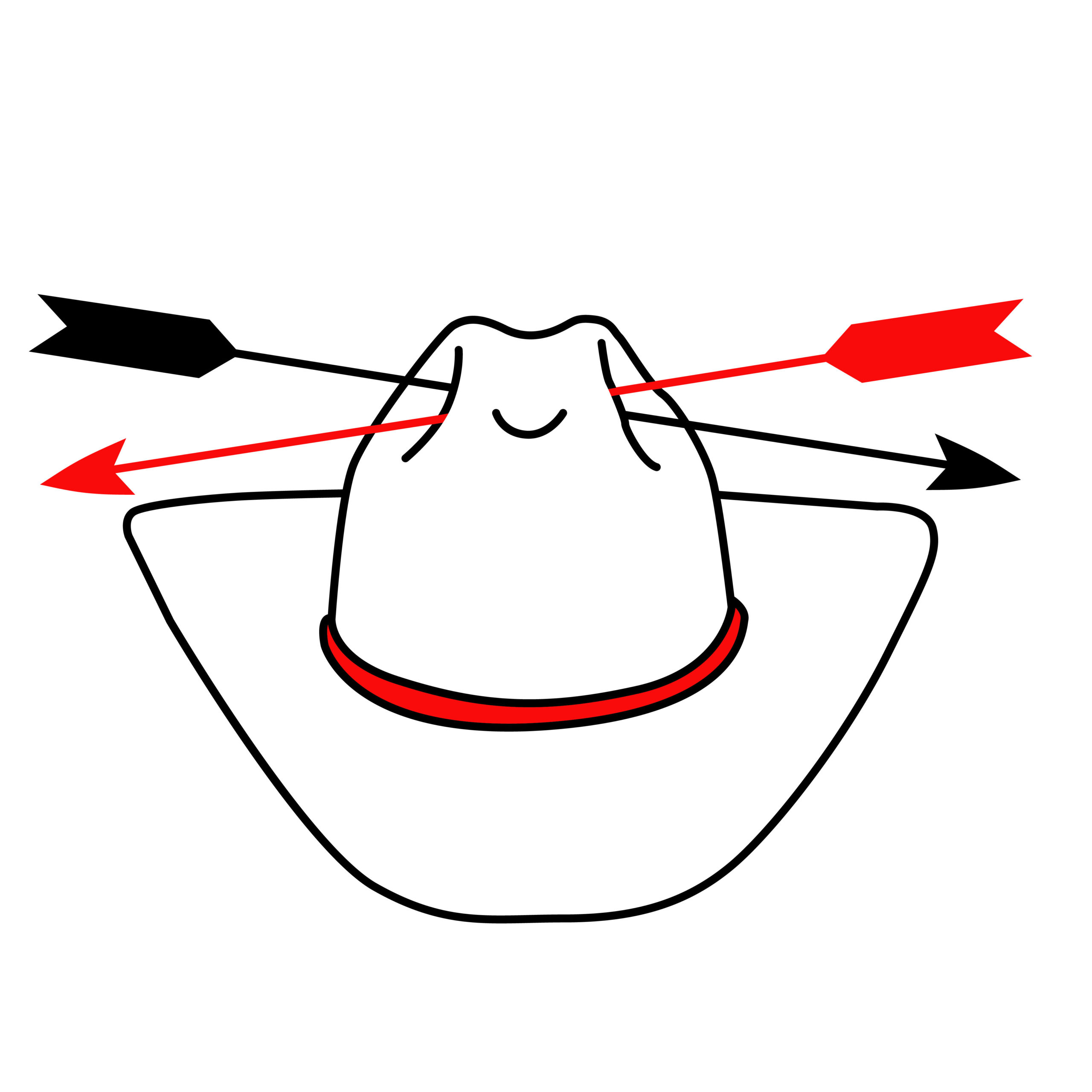
PATRIOTS AND POLITICS
Anti-indigenous activists have joined with far-right extremists to influence U.S. policy.
In the fall of 2019, two months before Matt Shea, a far-right Washington state representative, was found to have committed domestic terrorism for his involvement in planning multiple armed standoffs with antigovernment extremists against federal agents, he was recording his weekly show, Patriot Radio. The show broadcasts two times a week on the American Christian Network in the Spokane Valley, an area that includes numerous tribal nations. Shea started off the show as he does most of his others: He said a prayer, explained how Communists were tearing the U.S. apart, and finished his monologue by describing how liberty and Christianity were under threat from liberals in Seattle. Then Shea introduced his guest for the show, Elaine Willman. “I think you’re a blessing to everybody across the United States of America for everything that you’ve done,” Shea told her.
The interview was a meeting of two extremists. Elaine Willman is a decades-long anti-tribal sovereignty advocate and a former chair of Citizens Equal Rights Alliance (CERA), a group that aims to reduce or eliminate tribal governments, reservations, and their treaty rights. Shea’s focus is limiting federal government, a perceived persecution of conservative Christians, and protecting property rights. But Shea also shows how right-wing politicians and leaders are informed by people like Willman, who travel in the same circles and provide the voice of the Indigenous expert, with the political goal of undermining and ultimately eradicating tribal sovereignty. Their conversation on Patriot Radio revealed how these two groups—anti-Indigenous advocates and anti federal government extremists —have begun to merge. Their views align well because of their shared preference for state governance power, and their accusations against the federal government (with which tribal nations have a government-to-government relationship) of tyranny and overreach.
In the United States, anti-Indigenous sentiments most often come from non-Natives in conflicts over water, land, or wildlife—often by those who actually live on tribal land. Assimilatory and genocidal government policies have resulted in land seizures by non-Natives and, as a result, many reservations have a significant non-Native population. (This is the case with Willman, who lives on the Flathead Reservation in western Montana, where non-Natives outnumber tribal citizens by a ratio of two to one.)
Despite living on tribal lands, non-Natives often refuse to abide by tribal government laws. The first documented anti-Indigenous group in Montana, called Flathead Residents Earning Equality (FREE), began in 1969 in response to the Confederated Salish and Kootenai Tribes charging $5 for tribal recreation permits. FREE’s founder was blunt about its goal. “The ultimate solution is termination of the reservation and destruction of the Bureau of Indian Affairs,” the founder said. “What would happen if our next governor was an Indian? We’d all be down the drain.” FREE spawned multiple anti-Indigenous groups sporadically active to the present day; their purpose has always been to erode the political and legal power of tribal governments, and they’ve fought for this through U.S. courts and the ears of legislators, with some success.
Over the past few years, as extremism has gone mainstream, these ideas and others like them have increasingly found common cause among a number of Western state legislators in Washington, Idaho, and Montana. These legislators rarely speak directly about tribal rights—instead, they host people like Willman to speak for them. CERA encourages those relationships, billing itself specifically as an “instant training center” for elected officials, law enforcement, community leaders, and citizens concerned about federal Indian policy. In 2015, for example, Jennifer Fielder, a Montana state senator, spoke at a CERA conference about transferring public lands to local control. Fielder sat on the State-Tribal Relations Interim Committee and has opposed the Confederated Tribes of the Salish and Kootenai’s efforts to settle the amount of water they are owed by treaty right.
In 2018, CERA sponsored a conference in Montana, which brought together anti-government activists, conspiracy theorists, politicians and anti-Indigenous advocates in order to share ideologies. The conference included state representatives connected with the movement to put public lands under state control and those who believe a conspiracy that the United Nations is part of a plot to implement global totalitarianism. Shea attended the conference, but has generally been more reserved about his opinion on tribes. According to an investigation commissioned by the Washington state legislature in 2019, however, Shea has privately shared a document proposing a civil war, reinstituting homesteading, and a “final settlement with Indian tribes” in which tribes would “become part of the state.” That same investigation found Shea committed domestic terrorism, having planned multiple armed standoffs with antigovernment extremists against federal agents years previously.
On Shea’s Patriot Radio show, Willman repeated the usual barrage of myths: that tribal casinos give tribes “free money,” the “burden” that tribes place on the American taxpayer, and that upholding treaty rights has “diminished state sovereign authority.” At the end of the show, after hitting on almost every anti-Indigenous stereotype, Shea thanked Willman for her knowledge. “You’re not just an expert,” he said. “You’re always encouraging. God bless you.” —Anna V. Smith, High Country News

THE MEANING OF FORCE
Investigations reveal anti-Indigenous sentiments in the Royal Canadian Mounted Police.
Throughout the late 19th to the early 20th centuries, the majority of First Nations in what we now call Canada signed treaties that ultimately surrendered their territories to Canada. The Wet’suwet’en Nation, located in the central interior of British Columbia, is one of the few that never signed onto a treaty. In a landmark ruling in 1997 called the Delgamuukw decision, the Supreme Court of Canada concluded that the Wet’suwet’en never surrendered their lands by sale or treaty, and recognized Wet’suwet’en’s claims to Aboriginal title.
Late last year, tensions grew in the province of British Columbia after the Royal Canadian Mounted Police began to enforce a court injunction to allow the construction of the Coastal Gaslink pipeline on Wet’suwet’en territory. The RCMP arrested individuals who did not vacate sites that were set up to restrict access to their lands for the construction of the pipeline, such as the Gidimt’en Checkpoint, and demonstrations and railway blockades erupted throughout the country in support of the Wet’suwet’en peoples.
But within the RCMP, Wet’suwet’en have few supporters. In the spring of 2020, I attempted to gain access to a Facebook group for retired and currently serving RCMP members, administered at the time by a retired officer who was involved in leaking sensitive information about anti-pipeline protests. I was denied, but later was accepted into the group under a different name.
Posts from the group revealed disturbing attitudes against anti-pipeline land defenders, including offensive content where Wet’suwet’en rallies are discussed. This group is one of more than half a dozen similar RCMP groups that exist on the social media platform. They welcome RCMP members and their supporters and have over 12,000 members. The RCMP says they are not affiliated with the Facebook group.
Jaskiran Dhillon was the co-author of an article published in the Guardian that uncovered documents detailing how the RCMP had prepared to use lethal force against land defenders who opposed the construction of the pipeline, allegations that the RCMP has denied. “The resistance efforts of Indigenous land defenders and water protectors has always, historically, been met with tactics of colonial state violence,” Dhillon said.
According to Dhillon, the Northwest Mounted Police (NWMP) was created as Canada’s first policing agency to assert control over Western Canada in 1873. The NWMP was modelled after the Royal Irish Constabulary, a paramilitary police force. In 1920, the NWMP was renamed the Royal Canadian Mounted Police.
Dhillon said law enforcement was responsible for enforcing government policies that led to Indigenous land dispossession, residential school attendance and forced land relocations. The trauma inflicted by these colonial efforts has reverberated within Indigenous communities for generations, leaving a lasting impact.
As a youth, Sleydo’—whose English name is Molly Wickham—had the goal of becoming a lawyer to help achieve justice for Indigenous peoples. She said she has witnessed injustices perpetrated by the RCMP and Canadian courts her entire life. “There’s very few incidences, in my experience, where they actually were there to help people or protect people,” she said. Sleydo’, who serves as the spokesperson for the Gidimt’en Checkpoint, was one of more than a dozen people arrested. Sleydo’ told me the trust between Indigenous peoples and the RCMP has eroded.
These past few months have been marked by violence and death for Indigenous people in Canada. Earlier this summer, in British Columbia, Chantel Moore, a Nuu-chah-nulth woman of Tla-o-qui-aht First Nation, was shot by a police officer who was performing a wellness check on her. Eight days later in New Brunswick, Rodney Levi, a Metepenagiag Mi’kmaq Nation man, was fatally shot by the RCMP while he attended a barbecue at his pastor’s house. Around the same time, a video surfaced of the arrest of Chief Allan Adam, who is the elected chief of the Athabasca Chipewyan First Nation (ACFN), in northern Alberta. The video shows an RCMP member tackling Adam to the ground, punching him, and putting him in a chokehold after pulling up to Adam’s car in a parking lot.
According to Dhillon, the Facebook posts are incredibly dangerous and connected to the violence. “[The comments] communicate the message that both the RCMP and the local law enforcement support egregious acts of violence against Indigenous peoples, even the lethal harm of Indigenous land defenders,” she said.
Several concerning statements can be found throughout the group page. “So if a train went through a barricade slowly and a protestor did not move that would be a suicide concluded here right?” one retired RCMP member wrote. Many members agreed.
A video posted in the group shows a truck driving through a group of land defenders without stopping; the land defenders are then forced to move out of harm’s way. “Good, that’s the way it should be done,” a serving member of the RCMP wrote. “Agreed however knowing the RCMP’s luck, some protestor moron would fall and get run over,” another member responded.
“Suicide,” the active RCMP member wrote back.
APTN reached out to the RCMP headquarters for an interview, but the request was declined. “Given that we are looking into these incidents, it would be inappropriate for us to comment on how they might be interpreted,” they responded by email.
Sleydo’ said the Wet’suwet’en people have increasingly experienced violence at the hands of local community members. “I think that when the RCMP behaves like this, they’re inviting other members of the public to do the same kind of violence to us.”
Earlier this year, a truck drove through a highway blockade that was set up by Wet’suwet’en supporters in Manitoba. In Aril, a Secwepemc land defender reported her truck had been stolen and driven into the tiny house where she was located. The tiny houses were strategically constructed in opposition of the Trans Mountain Pipeline set to cross through their territory, and a memorial to Missing and Murdered Indigenous Women was destroyed in the process. —Brittany Guyot, APTN
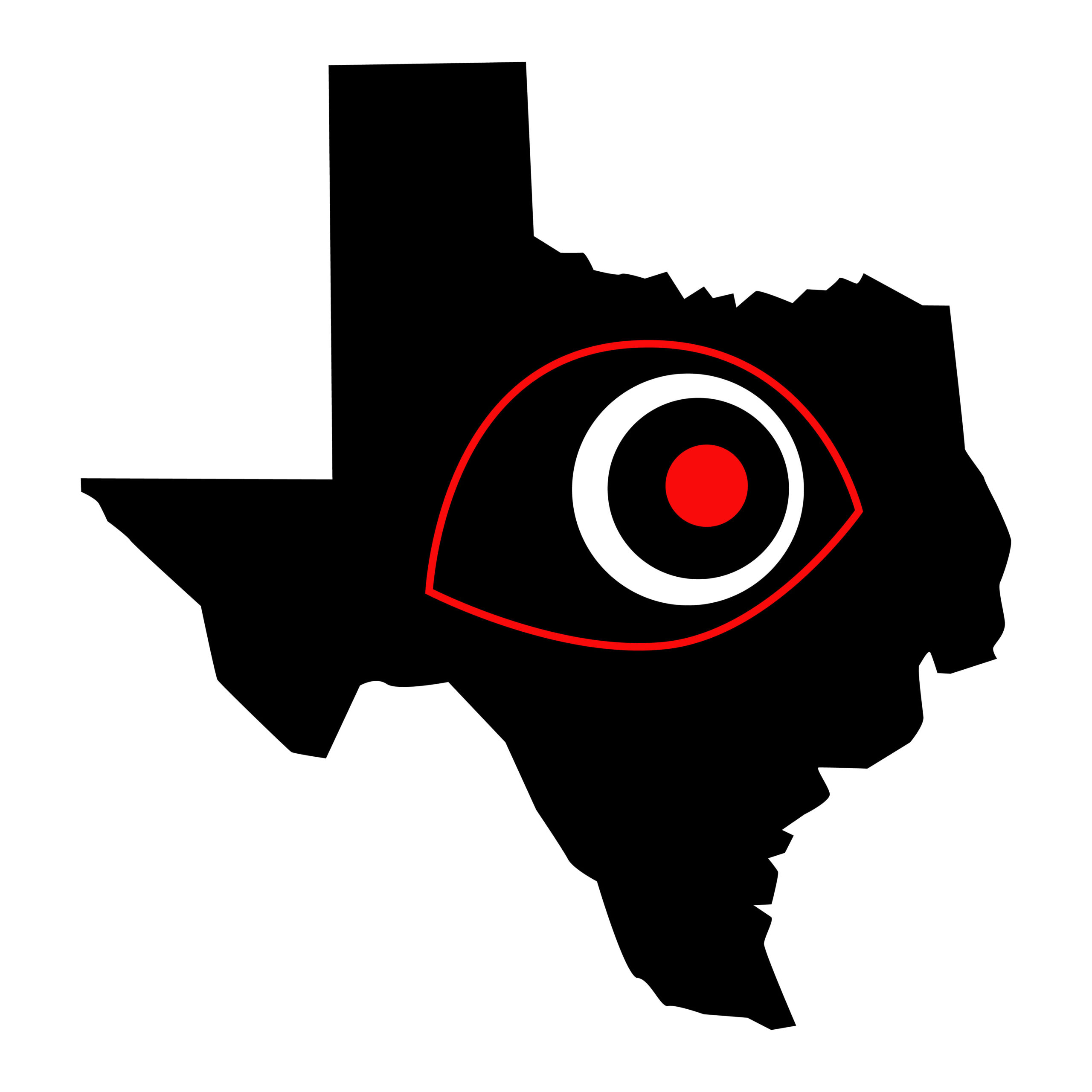
DISCRIMINATION IN THE LONE STAR STATE
A university built with stolen land whitewashes its past and silences its Indigenous students.
This May, as protests over the death of George Floyd spread across the globe and monuments to colonists and racists began to be pulled down, Texas A&M University faced its own reckoning. Since 1918, the school has had a statue of Lawrence Sullivan Ross on its main campus. Ross was a former president of A&M in the 1890s, as well as a Confederate general. His statue has been seen by students as a symbol of racism.
In June, A&M responded to the students, faculty, and staff who had called on the university to remove the statue by announcing the formation of a task force on race relations and a commission on historic representations, declaring that the two new groups would address representations of “people who contributed to Texas A&M throughout our history” and to establish “the expectations and behavior of our community to stand firmly against racism.”
“Everybody was kind of abuzz on campus,” Ried Mackay (Crow, Northern Cheyenne, Cherokee descent), said. “The students were like, ‘This could be something good,’ and then the Native students, we’re all just kind of like, ‘We’ll see.’”
A month later, A&M announced the members of the 45-person commission composed of members representing Black, Hispanic, and Asian students, sororities, student military organizations, athletic programs, former students, as well as representatives of different degree programs at the school. Nobody was listed as Indigenous or designated as a representative of Indigenous students or communities. “It was really disappointing,” Mackay said.
“While the commission is intended to gather a variety of perspectives among members of the university community, it’s simply not possible for any single committee to represent every background, belief, or interest group on campus or in the greater Texas A&M community,” a spokesperson for the commission said in an email.
Texas A&M, which was started in 1876, is a land-grant university and owes its beginnings to the passage of the Morrill Act, which, according to A&M’s website, “granted revenues from the sale of millions of acres of federal lands to states in order to create higher education institutions. More than 150 years later, the Morrill Act has proven to be a transformative piece of legislation not just for Texas A&M, but for the other universities that were founded under the original 1862 act.”
In total, the Morrill Act redistributed 10.7 million acres of land from across the United States to establish the land-grant university system. From Cornell University to the University of California, the grants of free land from the federal government raised money for 52 institutions.
However, that “free” land came at a price: It was taken from nearly 250 tribal nations through more than 160 violence-back land cessions. Through the Morrill Act, expropriated Indigenous land was transformed into university endowments.
Texas A&M received 180,217 acres through the Morrill Act, taken from more than 180 tribal nations spread across the Western U.S. When adjusted for inflation, the university raised approximately $3.7 million from the sale of those lands—a steal considering the United States paid only $124,421 for those same lands, if anything was paid at all. More than 70 percent of the territories obtained and sold by A&M were seized without payment through congressional act, unratified treaty, or by executive order.
In the fall of 2018, more than 69,000 students were enrolled at A&M, yet only 206 identified as American Indian, Native Hawaiian, or Alaska Native. Madeleine Flanders (Wanbli Wiyan, enrolled Oglala Lakota), the president of the Native American and Indigenous Student Organization (NAISO), thinks that recruitment of Indigenous students is a low priority for the university, but also says A&M has a reputation of being unfriendly to Native people. Flanders is a senior this year. She said that she has enjoyed her time at A&M, but she also describes herself as white-passing and said that hiding her Indigeneity has made it easier to fit in. “Once you can do that, you’re good to go,” Flanders said. “You’re accepted. You’re valued. But as soon as you say, ‘I’m Native American, and I want to be treated as a Native American person, and I want that to be the same treatment as any other race,’ that’s when A&M becomes a very unwelcoming place.”
“The feeling and the message I think [Indigenous students] hear is ‘you just don’t matter that much,’” Dr. Angela Hudson, a professor of American Indian history at A&M and NAISO sponsor, said. She referred to the commission, adding, “To me, the difference between 45 and 46 people is not huge.”
Texas A&M says that Indigenous students are invited to attend listening sessions and community forums to voice their concerns over the coming months, while the commission is expected to have a completed report by mid-November.
“The university has an obligation to acknowledge us as students, and to value us as students, and to make sure that we feel welcome here and make sure we feel represented,” Flanders said. “Our ancestors gave their lives for this university to be built.” —Tristan Ahtone, the Texas Observer
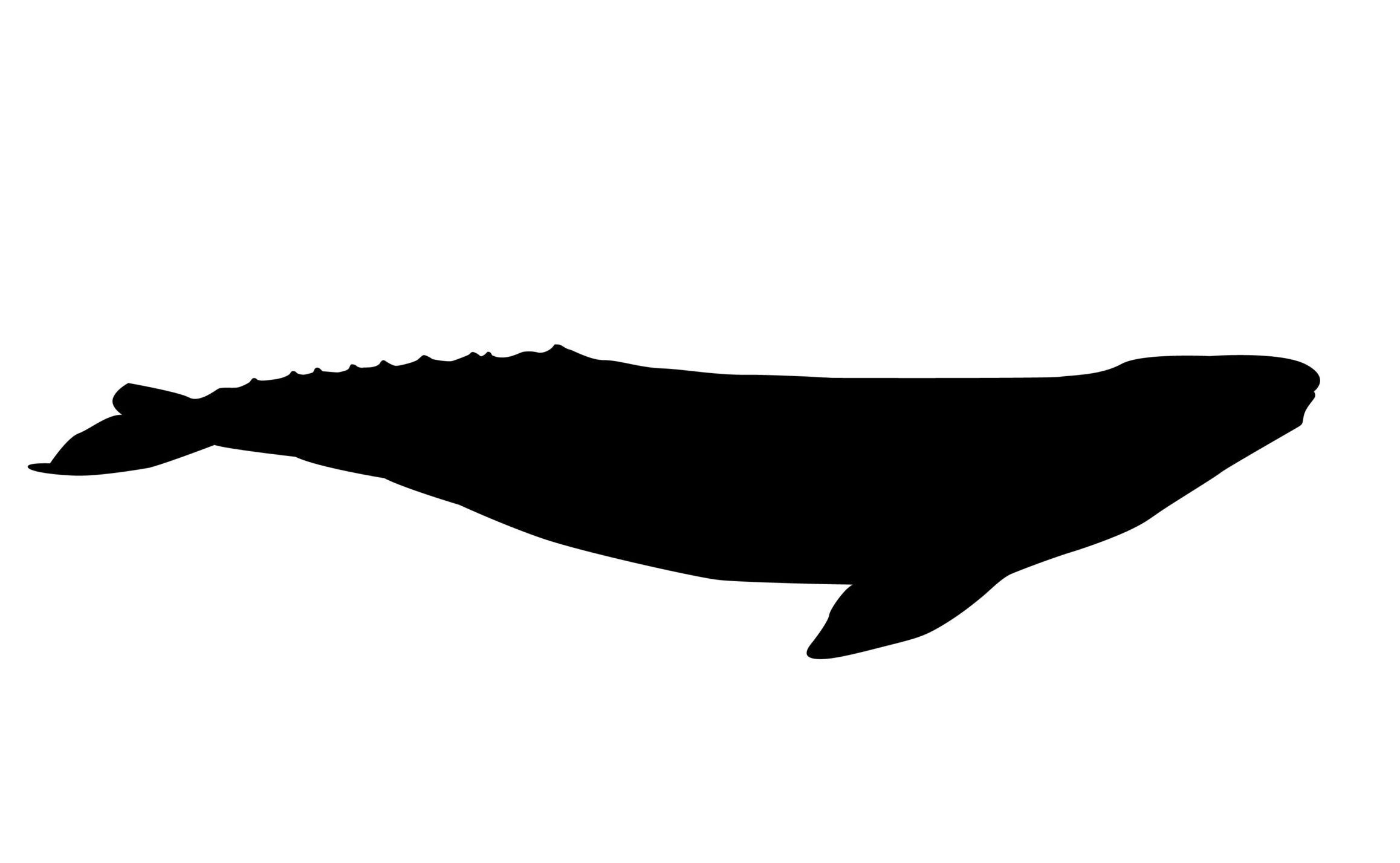
BREACHING DARK WATERS
Animal rights groups continue decades-long anti-Indigenous crusade against subsistence whaling rights.
One early May morning in 1999, off the misty shore of Cape Alava in Washington state and before protesters could arrive, the Makah Tribe harpooned its first gray whale in over 70 years. The hunters—in two motorboats and a seven-person cedar canoe—said a prayer for the whale, then towed in their 30-foot long catch. A fleet of outraged activists and fishermen met them in the water. Sea Shepherd, an anti-whaling group, led the way in a 95-foot-long vessel, blaring an angry horn.
The encounter was one of many skirmishes between anti-whaling activists and tribal members during the 1990s. For seven decades prior, the Makah Tribe had voluntarily ceased hunting whales, ever since global commercial whaling endangered the gray whale in the 1920s. In 1997, once gray whale populations recovered, the Makah Tribe secured a permit to hunt again. In response, anti-whaling activists began a sustained campaign to undermine the Makah’s treaty right to do so, calling the hunts “despicable” and “untraditional,” issuing bomb threats, breaking into tribal members’ homes, harassing tribal fishermen and posting “Save a whale, kill a Makah” signs at protests and as bumper stickers. The campaign was a success: For the past two decades, the conflict has been tied up in courts and federal bureaucracy, and the Makah have been unable to hunt since.
Animal rights and environmental activists like the Sea Shepherd Conservation Society and Animal Welfare Institute have long galvanized support from local residents, lawmakers and the courts to oppose and undermine tribal treaty rights. In the uncompromising attitude of the movement, activists have regularly denied the legal validity of treaties, and instead used anti-Indigenous arguments to keep tribal nations from land and wildlife management, and hunting and fishing on their traditional lands. Stereotypes pushed by majority-white organizations that tribal governments are incapable stewards persist; today, the Sea Shepherd Conservation Society still calls the Makah’s whale hunting “archaic” and “barbaric,” at once extending morality and rights to the animal world while denying the same for Indigenous people.
The animal rights movement gained momentum in the late 1970s and early 1980s, at the same time that many Indigenous nations were gaining political power and reasserting rights to water, land, and wildlife. As often happens when tribes assert their rights, anti-Indian sentiment grew. In Washington state, public opposition to tribal treaty fishing and hunting rights bloomed as a sweeping court decision in the 1970s reaffirmed those rights and called for tribal co-management of the fishery. The Skokomish Tribe and other nations experienced racist backlash fomented by groups like S/SPAWN (Steelhead/Salmon Protective Association and Wildlife Network), which had both an environmental and anti-Indigenous agenda. S/SPAWN had political clout; it was co-founded by conservative Washington legislator Jack Metcalf, who despised the “special privileges” of tribal nations. Sea Shepherd, created in 1977, and its founder, Paul Watson, were highly active in Washington, and came to form an alliance with Metcalf against tribes and the Makah in particular, despite being on seemingly opposite sides of the political spectrum.
Since the Makah’s last whale hunt in 1999, the battle has moved from the water to the courtroom. Sea Shepherd’s lawyers have argued the tribe’s treaty rights “infringe upon the rights” of non-tribal citizens and that the Treaty of Neah Bay was terminated once Washington became a state. They have called the Makah Tribe’s treaty rights “tantamount to extra special rights” for a group of people based on race and/or culture.” All three positions are common tropes wielded by the anti-Indigenous movement to fight tribal sovereignty and treaty rights, the cultural significance of Indigenous traditions, and their perceived infringement on non-Natives rights, including animals. “They have an interest in protecting whales, and that’s a laudable goal,” Chuck Tanner, co-founder of the Institute for Research and Education on Human Rights who has tracked the anti-Indian movement for over four decades, said. “But really the threat to whales haven’t been tribal subsistence hunters: It’s commercial fishing.”
The Makah Tribe’s efforts towards a new permit have stalled during the pandemic, and it’s unclear when they will whale hunt again. But conflicts like those over the Makah’s whaling rights will persist as long as animal rights and environmental groups cling to anti-Indigenous perspectives. As John Hoceyar, director of Greenpeace USA’s ocean campaigns, told High Country News in an email, “It is not for environmental groups to decide that treaties should be ignored.” —Kalen Goodluck, High Country News
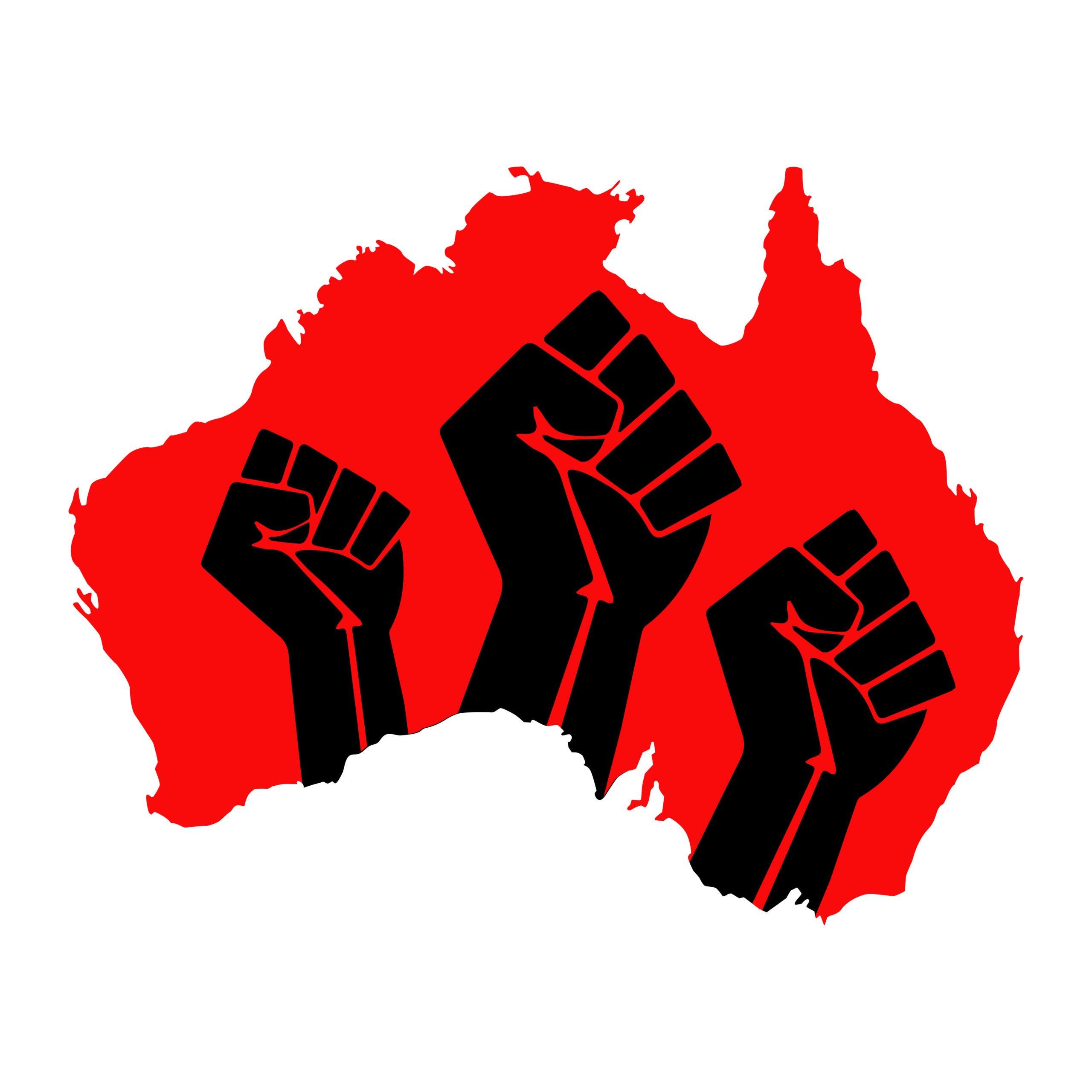
BLACK LIVES MATTER
Australian law enforcement has killed hundreds of Aboriginal people—without repercussions.
When First Nations people in Australia saw the horrifying footage of the death of George Floyd in Minneapolis, it triggered a deep anger and frustration that has coalesced around a number: 432, the number of Aboriginal people who have died in prison and police custody in the past 30 years.
First Nations people in Australia form the oldest continuous living cultures on Earth. Our recorded connection to this land goes back at least 60,000 years, and our history and our creation stories tell us we have always been here. Aboriginal people in Australia are from hundreds of nations, each with distinct languages, stories, land estates, and customs.
Since the arrival of colonizers in 1788, we have become the most incarcerated people on earth. First Nations people make up 2 percent of the general population, but we are 28 percent of the male prison population and 34 percent of the female prison population. Those figures are rising. This, along with the hundreds of Aboriginal people who have died at the hands of the police, sent thousands of people into the streets of Australia’s cities and towns, defying COVID-19 restrictions to join a local Black Lives Matter protest movement.
The rallies also became vigils to those lives lost. Lives like that of David Dungay, a 26-year-old man from the Dunghutti Nation, whose lands are around the northern New South Wales town of Kempsey. In 2015, Dungay died in a prison hospital after being restrained face down and knelt upon by five guards, who stormed his cell when he refused to stop eating a packet of biscuits. Dungay, who had diabetes and schizophrenia, said, “I can’t breathe,” 12 times before losing consciousness and dying. No charges were laid against the officers involved.
In 2017, Tanya Day, a Yorta Yorta woman, died from a brain injury after falling and hitting her head in a police cell. Ms. Day was not in custody because she was a threat to the community, or because she had been sentenced for committing a crime. Police couldn’t even say by what authority they held her for four hours after issuing her an infringement notice for being drunk in public. The coroner, Caitlin English, wondered “how it was Ms. Day was taken into police custody for her safety and ended up dying from an injury which occurred in custody.” No charges were laid.
More recently, phone footage emerged of a Sydney police officer slamming an Aboriginal teenager’s face into concrete during an arrest. The officer was put on restricted duties pending an internal investigation. The boy and his family say they intend to pursue a civil case against the New South Wales police.
That weekend, tens of thousands of people converged on Australia’s cities and towns to protest violence by the police, including a large gathering in Sydney that went ahead despite efforts from the police to block the rally through the courts.
“I am going to keep marching until we get justice for my son,” Leetona Dungay, David’s mother, said outside the court. “We buried him in Mother Earth, and that’s where I’ll walk tomorrow and every day, until charges are laid against the guards involved in his death.”
A second rally planned in Sydney in early August was declared illegal by the New South Wales Supreme Court, which dubbed the event a prohibited public assembly. The judge acknowledged that there was no evidence that the earlier rally, which had been attended by at least 10,000 people, had resulted in any transmission of the coronavirus, but the expert health evidence had since been elevated to “medium” due to multiple clusters in Sydney and the resurgence of the virus in Victoria.
Nevertheless, the rally went ahead as planned. The organizers were arrested and now face fines for breaching coronavirus restrictions on mass gatherings.
Paul Silva, David Dungay’s nephew, said the family was committed to peaceful protests. “We just know that violence isn’t going to solve this,” he told me. “These are peaceful protests, and we’re going to demand justice in a peaceful way until someone in government hears our voices and steps up to the table and says enough’s enough. We’re going to make systemic changes for this, and it’s got to happen sooner or later.”
The prime minister, Scott Morrison, said in July the “very high level of Indigenous incarceration” was a genuine issue, but warned against “importing the things that are happening in the USA to Australia.” Morrison told protesters to not “misuse” their liberty during a pandemic. Protesters said they knew the health risks but argued racism poses its own risks to Australia’s First Nations people. “Racism is a pandemic,” read a popular sign at the rallies.
Of the hundreds of deaths in police and prison custody since 1991—the year the nation held the Royal Commission into Aboriginal Deaths in Custody—there has never been a conviction. “There cannot be 432 victims and no perpetrators,” Alison Whittaker, a Gomeroi law scholar and poet, wrote in the Conversation. “All of this leaves our public discourse full of black bodies but curiously empty of people who put them there.” —Lorena Allam, The Guardian Australia
The authors, editors, and artists of this story gratefully acknowledges the Piscataway, Cherokee, Gadigal clan, Eora Nation, Sandia Pueblo, Tongva, Gabrielino, Honuukvetam, ‘Ahiihirom, ‘Eyoohiinkem, Carrizo & Comecrudo, Coahuiltecan, Caddo, Tonkawa, Comanche, Lipan Apache, Alabama-Coushatta, Cree, Kickapoo, Tigua Pueblo, Kiowa, Multnomah, Oj-cree, Kathlamet, Clackamas, Tumwater, Tualatin Kalapuya, Wasco, Molalla, Cowlitz, Watlala bands of the Chinook, Anishinaabeg, Iniwak, Nakota, Lakota, Dakota, Dene and Metis Nations, and their peoples past, present and future, whose sovereignty was never ceded and on whose traditional territories this journalism was created.
CREDITS: Tristan Ahtone, Lorena Allam, Francine Compton, Isabela Dias, Leilani Rania Ganser, Kalen Goodluck, Roberto (Bear) Guerra, Brittany Guyot, Anna V. Smith, McKenna Stayner, Diane Sylvain, Marty Two Bulls Jr.
Read more from the Observer:
No Place to Be: Cities have spent three decades criminalizing homelessness. Last year, Austin bucked the trend—and sparked a firestorm that still hasn’t gone out.
Death in Dalhart: After a farmworker in the rural Texas Panhandle died of complications from COVID-19, his family and federal investigators want answers.
The Wasteland Underwater: On the central Texas coast, Lavaca Bay is already poisoned by mercury. Climate change will only make matters worse there—and at 944 other hazardous-waste sites across the country.
